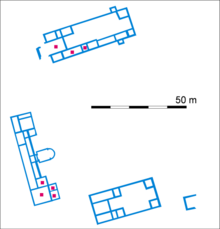Villa Rustica (Winterton)
The Villa Rustica in Winterton is a former Roman manor ( Villa rustica ) in Winterton in North Lincolnshire .
History of the excavations
The remains of a Roman villa near Winterton had long been known. In 1699, Roman remains are mentioned in a letter from Abraham de la Pryme. In 1747, mosaics were discovered by Richard Cowper, a farmer, who notified his landlord George Stovin (around 1695–1780), who visited the site two days later and uncovered a mosaic. Stovin wrote to the antiquarians William Stukeley and Francis Drake . The latter visited the place and had drawings made by Charles Mitley, which were published in 1789. Further mosaics were discovered in 1796 and 1797, which were also drawn and published. In 1957 it became known that the remains of the villa were endangered by iron mining. It was initially planned to find and lift only the mosaics, but the decision was then made to excavate the entire villa, as the iron mining was progressing more slowly than expected. The excavations lasted from 1958 to 1967 and were published in 1976.
The Villa
The complex of the villa consisted of a complex of several buildings, which were grouped around a large courtyard. In the west stood the actual house. In the north and south there were large buildings, which probably served economic purposes, in which there were also living spaces. The Orpheus mosaic, the largest mosaic in the villa, was found in the northern house. Each of these is a building with a large central hall with three naves. In the north, near the central residential building, there was also a somewhat smaller bathhouse.
The villa was likely built in the early 2nd century and flourished in the 4th century. Most of the mosaics also date from this period. The oldest structures were two round stone buildings, which, however, suffered greatly from the later development. The function of these round buildings is unknown. It has been suggested that they were temples. However, this would mean that a temple complex was converted into a villa in the second century, which is very unusual. Therefore, it was probably also a question of the buildings of a villa, which in its form continued Celtic traditions, but already incorporated Roman traditions in the building materials.
At the end of the second century the round buildings were torn down and the villa complex was built. This radical change indicates a new owner. The villa was richly furnished as early as the second century. Two rooms were decorated with mosaics, which was rare in second century Britain. In the fourth century the villa was reduced in size, but better equipped. Various rooms received mosaics and the main house received a dining room with an apse .
The remains of six mosaics were found in the villa, which were marked with letters in the full excavation publication. The largest mosaic (A) shows Orpheus in the middle of a circle; around him various animals are shown in a further, outer circle. When it was first found, the mosaic was better preserved. There are old drawings of it, but it remains unclear what could really still be seen in the 18th century. The traditional drawing does not show Orpheus in the center of the mosaic, but a sitting bear in a frame. A bear in the center of a mosaic would be highly unusual. The frame is probably the misunderstood lyre. Eighteenth-century draftsmen had obviously misunderstood the figure at the center of the mosaic. Another mosaic (C) shows in the center a medallion with a bust holding a cornucopia . Another mosaic (B) in a neighboring room (12.19 × 3.96 m) also shows a medallion with a bust in the center, which is identified as Ceres . Mosaic D is only preserved in three fragments and shows a geometric pattern. These mosaics probably date to the middle of the fourth century. Two other mosaics were only partially preserved and again show geometric or stylized plant patterns. They probably date to the second half of the second century.
Extensive remains of wall paintings came to light during the excavations . Most of the rooms were painted with field decorations, the bases of which show painted marble imitations in at least some rooms. Relatively well-preserved remains of figural scenes were found in the bathroom. They seem to represent nymphs and erotes at one source. Other painting fragments from the bathroom represent fish.
About 100 coins were found, the oldest dated under Domitian to the first century, but most to the fourth century, the last coin under Honorius , which indicates that the villa was still in use until the end of the fourth or even the fifth century. Window glass shows that the windows were glazed. There were two types. The first and second century glass is smooth on one side and rough on the other. Most of the window glass dates to the third and fourth centuries and is smooth on both sides. It was made from glass cylinders and is thinner than the one from the first and second centuries. Other finds were numerous ceramic shards, pieces of jewelry such as fibulae , but also glass from vessels.
literature
- IM Stead: Excavations at Winterton Roman Villa and other Roman Site in North Lincolnshire, 1958-1967. London 1976, ISBN 0116705701 .
Coordinates: 53 ° 39 ′ 2 " N , 0 ° 37 ′ 30.9" W.


